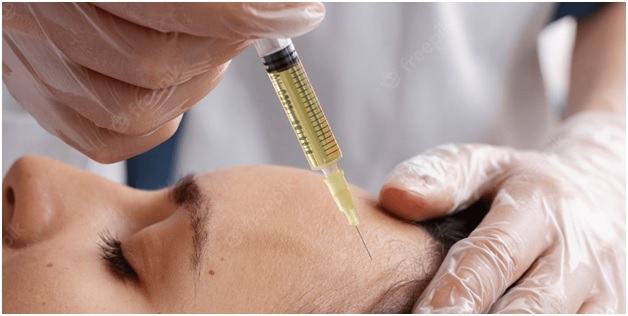The medical procedure known as platelet-rich plasma (PRP) therapy uses the patient’s own blood to enhance healing and reduce inflammation. It has been more well-liked recently as a non-surgical treatment option for a range of ailments, including sports injuries, chronic wounds, and cosmetic issues. But what is PRP therapy really, and how does it operate? The fundamentals of PRP therapy, its possible advantages and disadvantages, and its uses in the medical and cosmetic industries will all be covered in this article.


Learn what PRP therapy is, how it works, and if it might be right for you.
1. How Does PRP Therapy Work?
A little sample of a patient’s blood is drawn for PRP therapy, and it is processed to concentrate the platelets. Growth factors and other bioactive chemicals found in platelets can promote tissue regeneration and repair. In order to speed up healing and lessen pain and inflammation, the concentrated platelets are then injected back into the patient’s body at the site of an injury or problem area. The majority of patients can resume their regular activities right away after the procedure, which is often finished in within an hour.
2. What Are the Benefits of PRP Therapy?
PRP therapy provides a number of potential advantages, including increased tissue regeneration, quicker healing times, and less pain and inflammation. Numerous ailments, such as osteoarthritis, strained muscles, tendon and ligament injuries, and chronic wounds can all be treated with it. In comparison to other treatments, PRP therapy has a lesser risk of infection or allergic reaction because it uses the patient’s own blood. Additionally, PRP therapy is frequently a non-surgical choice, which may appeal to patients who want to avoid the dangers and recuperation time connected with surgery.
3. What Are the Risks of PRP Therapy?
Although PRP therapy is typically thought to be risk-free, there are some possible hazards and negative effects. Infection, hemorrhage, nerve damage, and allergic reaction are a few of these. There is also a chance that the therapy won’t work or that it may take several sessions to see the desired effects. Before receiving PRP therapy, patients should speak with their doctor about the advantages and disadvantages of the procedure and reveal any existing diseases or medications they are currently on.
4. How Much Does PRP Therapy Cost?
Depending on the practitioner, the ailment being treated, and the required number of treatments, PRP therapy might range in price. PRP therapy is often more expensive than other forms of treatment, although in some cases, insurance will pay for it. To find out how much PRP therapy will cost and whether it will be covered by their insurance, patients should speak with both their healthcare provider and insurer.
5. How Do I Prepare for PRP Therapy?
Patients should disclose to their healthcare practitioner any medical issues they may have or any medications they are currently taking before beginning PRP therapy. To lower the risk of bleeding, it is also advised to refrain from taking some medications for a few days prior to the procedure, such as aspirin and ibuprofen. To make the blood draw easier, patients should consume a light meal before the procedure and drink plenty of water. Patients should also wear loose, comfortable clothing that may be quickly undone to expose the treatment region.
6. What Should I Expect During and After PRP Therapy?
A tiny amount of blood will be taken from the patient’s arm during the treatment and processed to concentrate the platelets. The injured or problematic area is subsequently treated with an injection of the concentrated platelets back into the patient’s body. Although the injection may be uncomfortable or painful, the technique is typically well-tolerated. Patients may suffer some little swelling or soreness following the procedure, but these side effects are typically manageable with over-the-counter pain relievers. After treatment, the majority of patients can return to their regular routines right once, but they should avoid intense activity for a few days. It could take weeks or months for the full results of PRP therapy to manifest.
7. Are There Any Side Effects of PRP Therapy?
Even while PRP therapy is typically thought to be safe, there are some possible negative effects. These include bruising, infection, and transient pain or swelling at the injection site. Additionally, there is a slight chance of nerve damage, especially if the injection is administered close to a nerve. Although rare, allergic responses can happen. Prior to receiving PRP therapy, patients should discuss the potential risks and advantages with their healthcare physician.
8. How Often Should I Have PRP Therapy?
The ailment being treated and the patient’s unique reaction to the therapy determine how frequently PRP therapy is administered. Multiple sessions could be necessary to acquire the best outcomes for some disorders, such osteoarthritis. The sessions are normally separated by a few weeks to give the body time to heal in between sessions. Patients should consult their doctor about the suggested course of treatment, and they should follow up frequently to check on their progress.
9. Where Can I Get PRP Therapy?
PRP therapy is a medical procedure that is provided by a range of healthcare professionals, including dermatologists, sports medicine experts, and orthopaedic surgeons. To achieve the best results, it’s critical to select a qualified physician with PRP therapy experience. Patients might go online for nearby healthcare professionals or request a referral from their primary care doctor. Additionally, PRP therapy clinics and facilities, like PRP Therapy Canada, provide a variety of treatments for a wide range of ailments. Before getting PRP therapy, patients should do their homework on potential practitioners and clinics to be sure they are receiving a secure and efficient course of care.
Conclusion
PRP therapy is a medical procedure that is provided by a range of healthcare professionals, including dermatologists, sports medicine experts, and orthopaedic surgeons. To achieve the best results, it’s critical to select a qualified physician with PRP therapy experience. Patients might go online for nearby healthcare professionals or request a referral from their primary care doctor. Additionally, PRP therapy clinics and facilities, like PRP Therapy Canada, provide a variety of treatments for a wide range of ailments. Before getting PRP therapy, patients should do their homework on potential practitioners and clinics to be sure they are receiving a secure and efficient course of care.
























